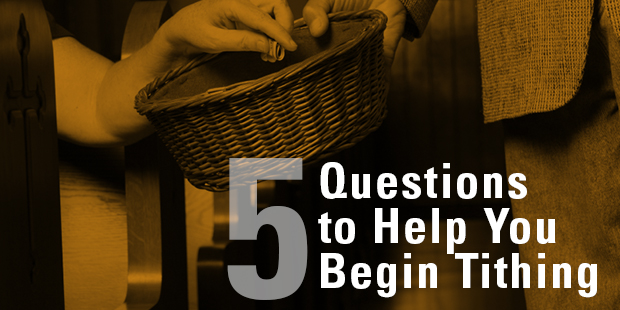
5 Questions to Help You Begin Tithing
Whether it was because of a recent sermon series, the testimony of a friend,a convicting book, or even the Bible itself, you’re seriously considering regularly tithing to your local church.
That’s great news. This is a huge spiritual turning point!
But it’s not quite as easy as simply writing checks. Even with the best of intentions, taking that step from irregular contributor to disciplined giver can be difficult. Answering these five questions will help get your new discipline off on the right foot.
1. Is your spouse on the same page?
If you’re married, big financial decisions need to be made together. So it’s important to discern if God is speaking to your spouse, or if he’s been working on you first.
It’s helpful to sit down and have an initial conversation and see where it leads. It doesn’t need to start with, “I’ve decided that . . .” This introductory discussion should begin with simply addressing your growing conviction. If they’ve been feeling the same prompting, great! If not, it’s time to take it back to God.
The next step is simply praying the Spirit would move in your mate’s heart. You can trust that if he’s working with you, he’s working on them, too. After a while, you can gently bring it up again. But make sure that your spouse doesn’t feel you’re confronting or nagging them.
If God is convicting you about giving and your partner is against the idea, then consider it an opportunity to pray that the two of you can be in the center of God’s will together. Don’t feel the need to be the Holy Spirit to your loved one.
2. How much do you plan on giving?
The word “tithe” literally means ten percent, but we often use it to describe any regular giving. Instituted in the Old Testament by Moses, the tithe was an obligatory offering for the Jews.
I think ten percent is a great place to start, although it might feel like a lot and you could be hesitant to start there. Or maybe you have a fantastic income and ten percent doesn’t feel like enough.
Either way, the important thing is that you get into the habit of giving regularly. Giving seven percent regularly is much better than giving $20 occasionally. Once you realize that giving that $.07 out of every dollar isn’t hurting you too bad, you can make the jump to $.10.
When you get your giving statement at the end of the year, it’s good to take that time and reevaluate the percentage you’re giving and whether you’re ready to give more. When God increases our income, it isn’t his intention to simply give us a better standard of living. He desires to see us be willing to give away more of what we have.
If you’re interested in learning what the Scriptures have to say about tithing, check out 20 Bible Verses on Tithing.
3. Where will you make sacrifices?
Let’s face it, no one just has ten percent just lying around that they’re not using. And if we’re just giving what we feel like we can afford to give away, we’re probably not being as generous as we should be. It’s important for all of us to look at our spending habits and see if there is money that could be better spent investing in the kingdom.
So if we decide you’re going to starting tithing ten percent of your income, it’s important to decide where it’s coming from. Fewer trips to Starbucks? A smaller cable package? If you don’t make this decision on the front end, you’ll find it really hard to practice regular giving.
4. When will you tithe?
This may seem like a silly question, but it can make all the difference in the world. You don’t have to give every week. You may give bi-weekly or it may be once a month. It’s helpful to think through when you get paid and when your larger bills are due. Once you sync your giving up with your financial schedule, you’ll find it a lot easier to give.
5. How will you pay your tithe?
How the church has made offerings has been in flux since God gave the law to Moses. Thankfully we don’t actually bring a percentage of the goods we actually produce to our congregation anymore.
But think about how many checks you’ve written in the last year. If you’re like me, it’s literally less than ten. And cash? Forget about it. Having cash in my pocket is such a rare occurrence.
If I had to rely on remembering my checkbook or stopping to withdraw cash on my way to church, I would never give regularly.
It’s important to find a payment method that make sense to your lifestyle. If most of your bills are paid electronically, it only make sense to give that way, too. Companies like Pushpay provide hassle-free options to electronic giving.
If your church isn’t offering an electronic giving solution, talk to your pastor. And if you are a pastor . . . we would love to show you how Pushpay works for your church!
You’re ready. Start tithing!
Once you work through these questions, you’re ready start on an odyssey of generosity. Learning to live generously with open hands is such an important step in becoming a mature Christ follower. You’re going to be thankful you started!
Interested in discovering what the Bible has to say about tithing? Check out the Tithing in the Old Testament Scriptures infographic, and 6 Views on Tithes and Offerings in the Early Church!
And pastors, if you’d like to know how you can begin to turn your church into a culture of generosity, check out our free ebook Why 80% Don’t Give: Becoming a church led by generosity.
Would you like to learn more about tithing and generosity? Connect with an Auxano Navigator and start a conversation with our team.

Tags: Jayson Bradley, Tithing














